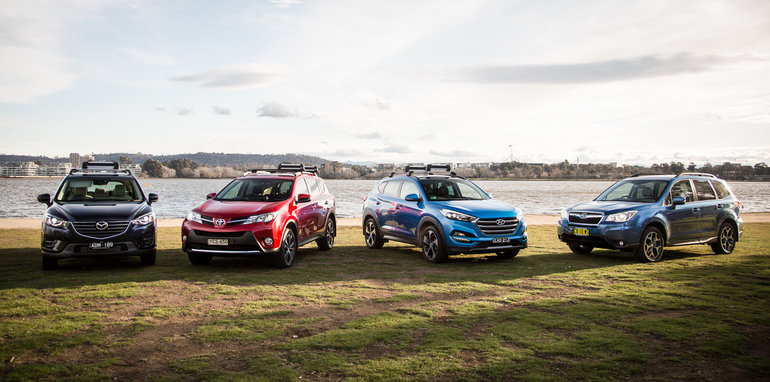
The just-released Hyundai Tucson is gunning to shoot Mazda’s CX-5 off its perch as the top-selling mid-sized SUV range in Australia. And if first impressions are anything to go by, the Korean threat to Japanese domination looks very real indeed.
The now-defunct Hyundai ix35 that the revived Tucson nameplate replaces was a long-term top-seller, but a lukewarm performer in CarAdvice testing: an eight out of ten at best, a terrible five and a half at worst. But Australia’s love of the ix35, propelled largely by styling and value, made it the market’s second-best seller (though it was always anachronistically classified as a Small, rather than Medium, SUV).
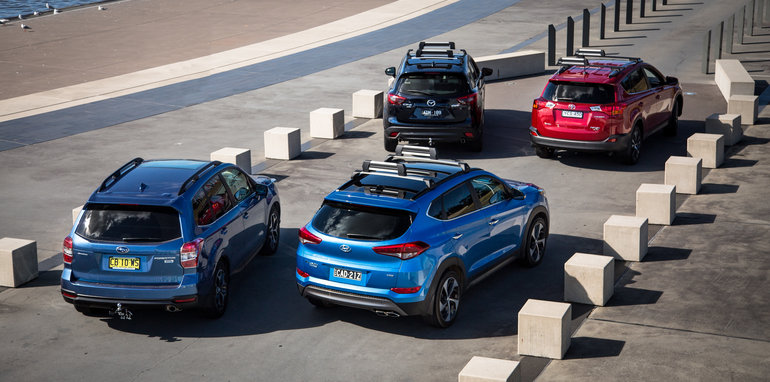
That, for instance, the top-spec ix35 Highlander diesel was, at $40,990, almost $10K more affordable than a similar grade Mazda CX-5 Akera 2.2 was one helluva dangling carrot for budget-savvy buyers. Â Â Â
And yet the CX-5, as a range, remained the sales top dog.
Enter the Hyundai Tucson, with eye-catching and contemporary styling, increased size, roomier accommodation, improved refinement and comfort…and a solid eight out of ten out of the box at launch (see here). In top-tier Highlander 2.0 CRDi AWD diesel form, as sampled in this four-way comparison, spec is generous and engine outputs are dominant. And at $45,490 before on-roads, it splits its forebear and the top-of-the-heap CX-5 Akera AWD diesel â€" in this test our faithful Melbourne long-termer â€" neatly on price, undercutting the Mazda by a substantial $5120. All the right stuff, then, to go toe-to-toe with the champ.
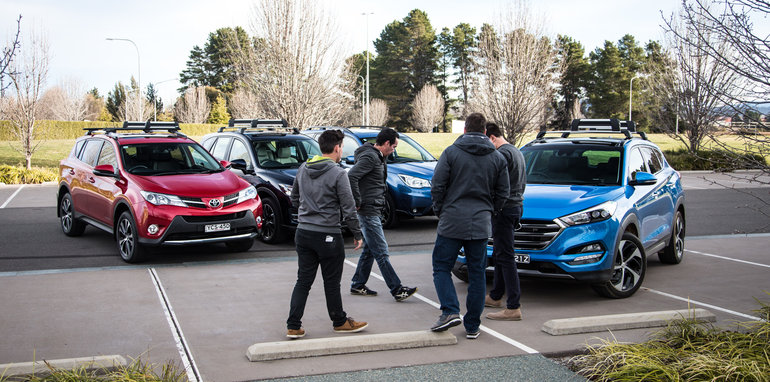
Keeping this pair honest in the value stakes is the recently updated Subaru Forester, in long-awaited and newly introduced diesel automatic form in high-spec 2.0 D-S trim, landing at a red-hot $41,490 before on-roads and options. Blind Freddy could see the generation gap between Fuji’s family hauler and, well, any of its rivals, though the Forester serves to make the Tucson work hard for its $4000 premium. In a recent CarAdvice two-car test, this very example of the 2.0 D-S scored a decent seven-and-half-from-ten victory over the Mitsubishi Outlander (check out the review here).
Toyota wants a handsome penny ($48,490 plus on-roads) for its RAV4 Cruiser AWD diesel, the big boy in a range that’s scored a seven at its fourth-gen 2013 launch and has failed to rise above a six since in various guises. Mostly from lacking solid value for money. But Aussies love them, and at last count year-to-date the RAV4 has robbed the ix35 of its second-best-selling mantle. It’ll be interesting to see, then, how Tucson measures up on merit in the face of such a bulletproof brand.
Features
The price-leading Forester is not only the sole permanent all-wheel drive of the four, it’s also hardly barren in standard spec: Xenon main beam headlights, a reversing camera, a new 7.0-inch touchscreen infotainment system with sat-nav and voice command, six-speaker audio, Bluetooth/USB, cruise control, dual-zone climate control, smart key/push button start, a multifunction steering wheel, powered mirrors, leather-appointed seats, first-row electric seat adjustment and heating, automatic tailgate, rain-sensing wipers, a first-row sunroof and 18-inch wheels.
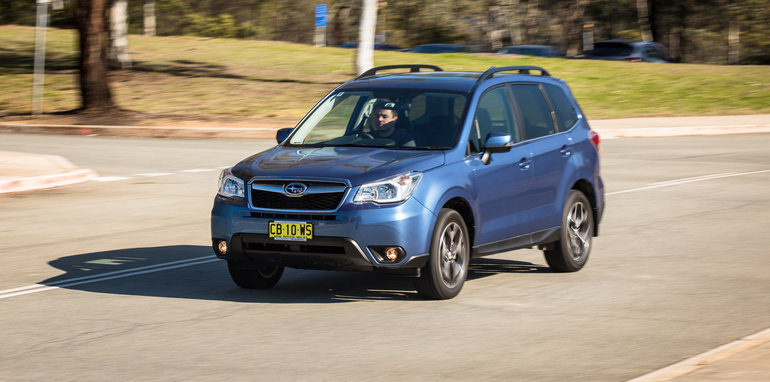
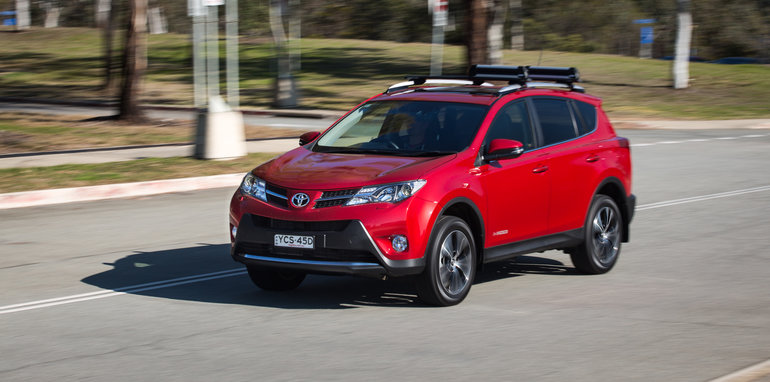
While X-Mode electronic off-road functionality is a Subaru exclusive, Subaru’s handy EyeSight suite of driver safety assists (which includes adaptive cruise) and auto stop-start aren’t offered in diesel variants. The lack of parking sensors, too, is a glaring omission.   Â
The RAV4 shares these features, but adds digital radio and has an 11-speaker stereo, though seats are ‘leather appointed’ with only driver’s-side electric adjustment, the wipers aren’t rain-sensing and the touchscreen system is a modest 6.1 inches. The Toyota is, however, fitted with rear parking sensors to complement the reversing camera, hill descent control, lane departure warning, blind spot monitoring and reverse cross traffic alert functionality.Â
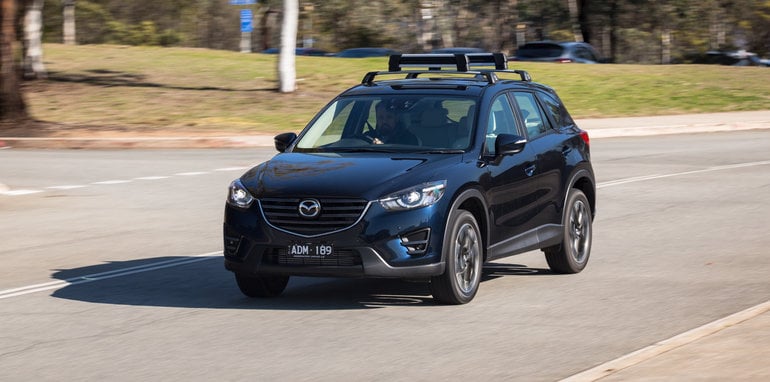
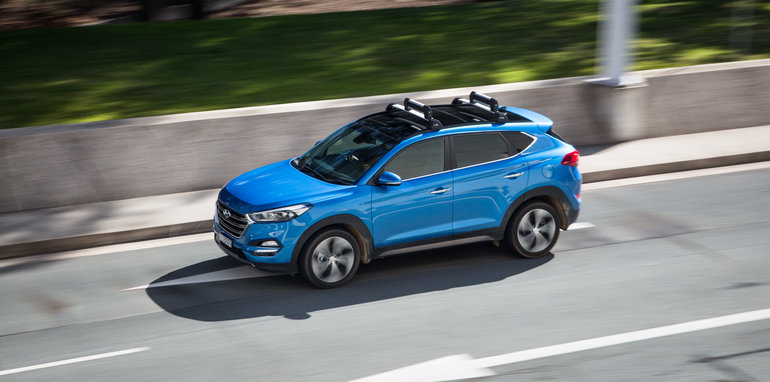
As the priciest of the quartet, the CX-5 has a healthy list of standard equipment: adaptive LED headlights, LED design fog lights/DLRs/tail lights, leather trim, heated electric front seats, nine-speaker Bose audio, 7.0-inch touchscreen infotainment with rotary controller and sat-nav, adaptive cruise control and front row sunroof. Omissions of note include a lack of roof rails and no powered tailgate functionality.
The Hyundai keeps the Mazda honest on spec, with a complete suite of LED exterior lighting and ‘static bend’ headlight tech, heated and cooled electric front seats, leather/leatherette trim, 8.0-inch touchscreen infotainment, six-speaker audio, electric folding/heated side mirrors, cruise control, rain-sensing wipers and a full-length panoramic glass roof. However, Apple CarPlay smartphone connectivity is not yet offered on the top-spec Highlander version of the Tucson (it’s available further down the range).Â
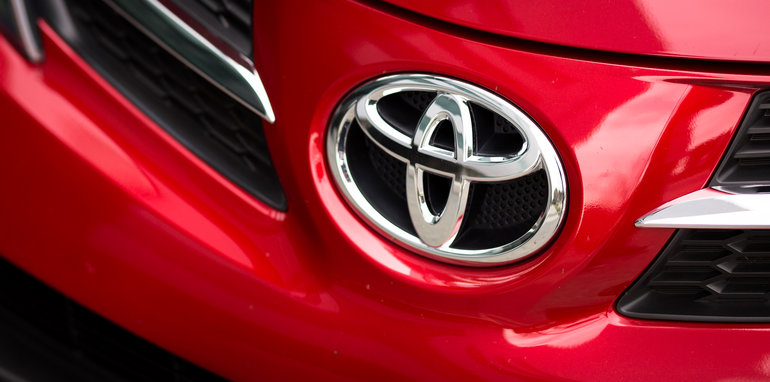
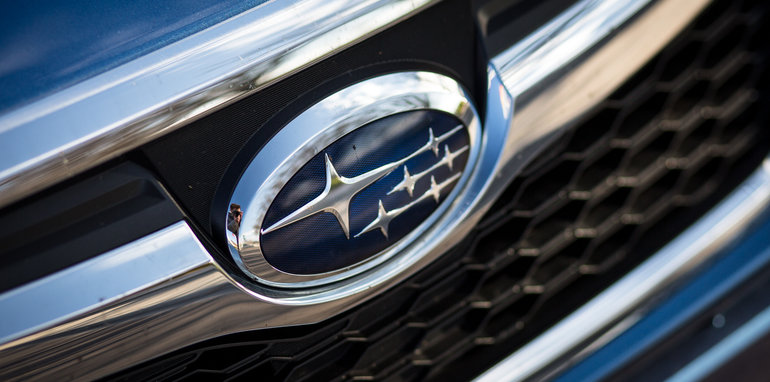
Both the Hyundai and Mazda have healthy active safety lists featuring blind-spot monitoring, lane-keeping assist/lane departure warning and rear cross traffic alert. The Mazda boasts kerb-side video monitoring, forward obstruction warning and both front and rear City Brake support; the Hyundai countering with Autonomous Emergency Braking with pedestrian recognition, Trailer Stability Assist and Advanced Traction Cornering Control (which brakes the inside rear wheel). Â
The Hyundai and Mazda are the only two competitors to offer front and rear parking sensors together with reversing cameras and electric parking brakes. Both, too, sit on 19-inch wheels.
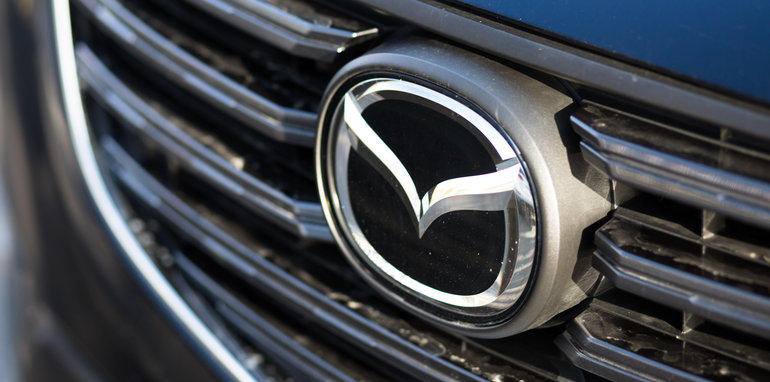
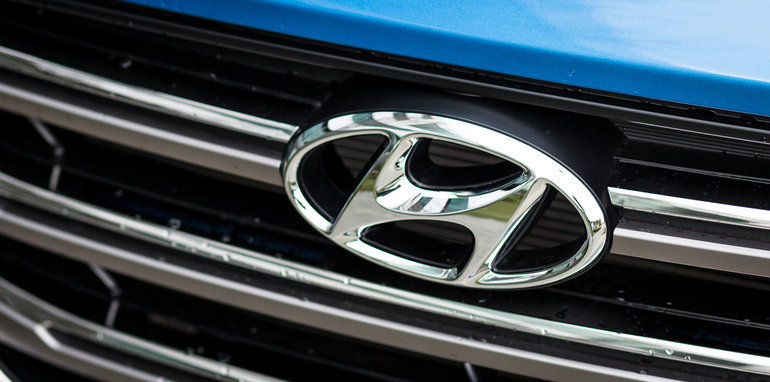
For on-paper value, then, the newcomer Tucson takes the early points.
Exterior Design
As the new boy, and the impetus for this comparison, the Tucson leverages contemporary design to maximum effect, at least in full bells and whistles Highlander spec. And where its ix35 forebear sat on the fence between small- and medium-SUV sizing, the longer and wider Tucson looks to be confidently the largest of this assembled four.
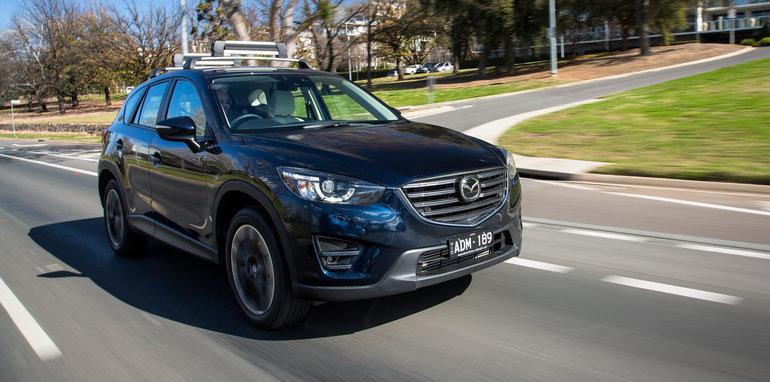
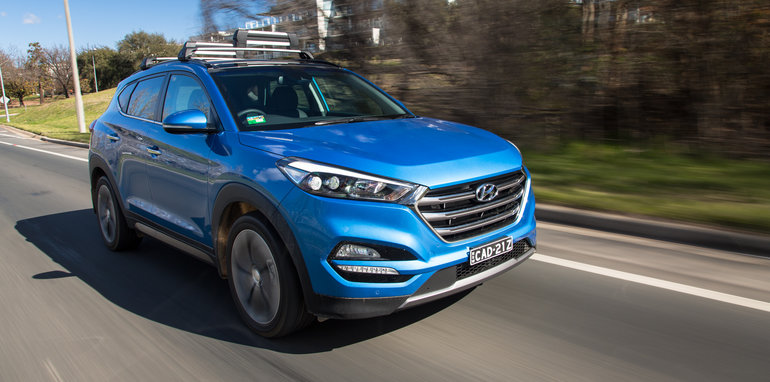
From fifty paces you’d swear the Hyundai confidently dwarfs the CX-5, but it doesn’t. In fact, the Tucson is 65mm shorter in length. The Mazda has been something of a style champion of the segment and it’s hard to argue the looks and visual impact have contributed to CX-5’s popularity. Both share a tapered belt line in profile â€" the glass line flowing high to low from rear to front â€" which help, in no small way, in making the pair look a generation fresher than the RAV4 or Subaru.    Â
The Forester is case of ‘Hello old friend’, though its more traditional, slab-sided look, with its generous glass area all round, is ageing gracefully and certainly appeals to many buyers’ tastes given its continuously strong sales.
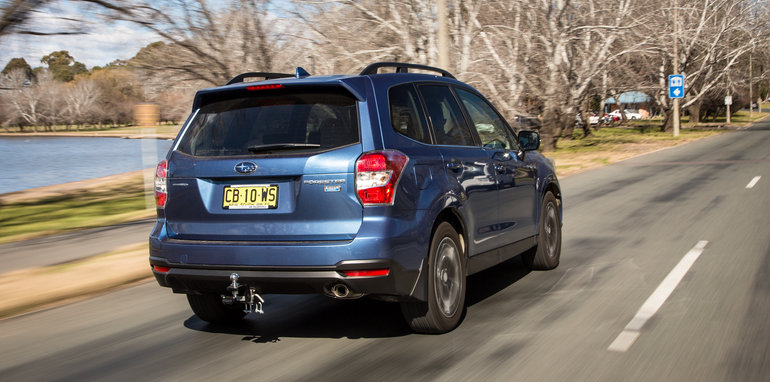
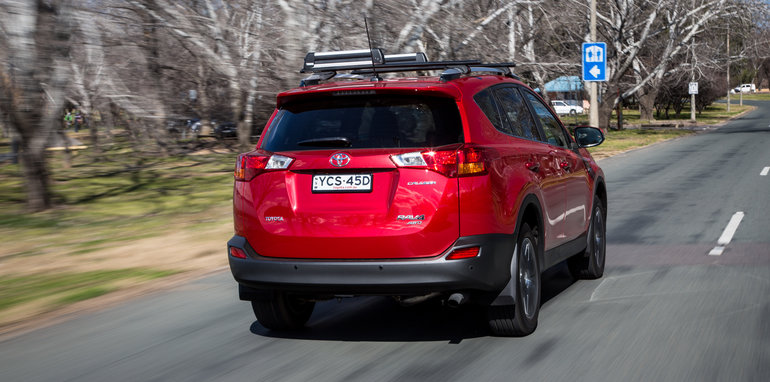
It’s from the rear where the Forester is beginning to look old hat, particularly with the square taillights. With its sharper front-end treatment and more angular horizontal taillights, even the RAV4, face-lifted back in 2013, looks markedly slicker and newer by comparison. Works a treat, too, if the Toyota’s tireless popularity with buyers is anything to go by. Â
Familiar and traditional? Or fresh and flashy? This quartet covers a broad spectrum of personal ownership tastes. And thus, not one of this four should score higher than its rivals on styling alone. However, the trend towards sexier tapered body styles does impact on certain practicalities in such a practicality-focused segment. Â Â
Interior
While appearing a minor quibble, the window line in the second row of the Tucson is so high that a five-year old in a booster seat â€" my son, as is the case â€" won’t be able to see anything but sky through the narrow side window. For many buyers, it’s a non-issue, but if you’ve got small children who face death by boredom without a clear view of the passing world from row two, this lack of rear vision could be a deal-breaker.
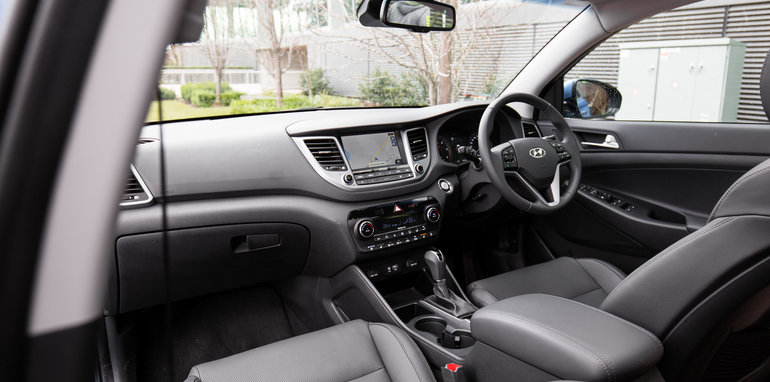
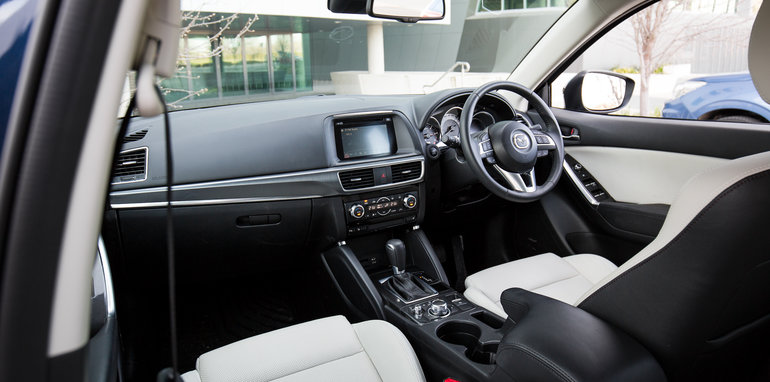
The issue isn’t quite as bad in the CX-5, nonexistent in either the RAV4 or Subaru. In fact, the Forester has the best all-round vision in all seating positions, in part thanks to that ‘classic’ high-set seat positioning that medium SUVs seem to be beginning to steer away from in favour of more car-like low-slung arrangements.
That said, it comes to detriment of cabin space. The Subaru is fairly roomy, with ample knee, foot and shoulder room, but it does have the tightest headroom of the bunch, especially in the second row, and won’t be most comfortable for hauling adults.
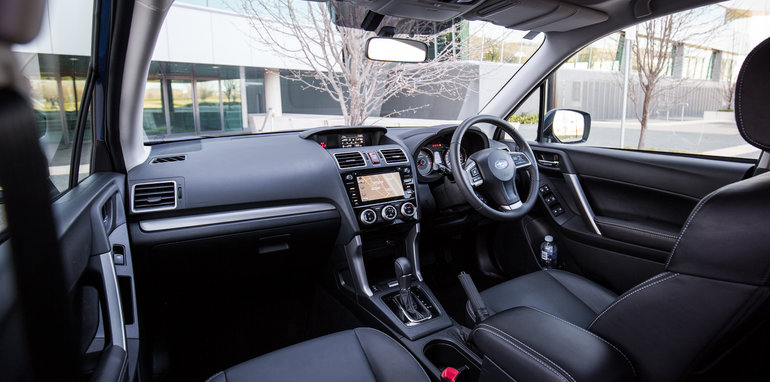
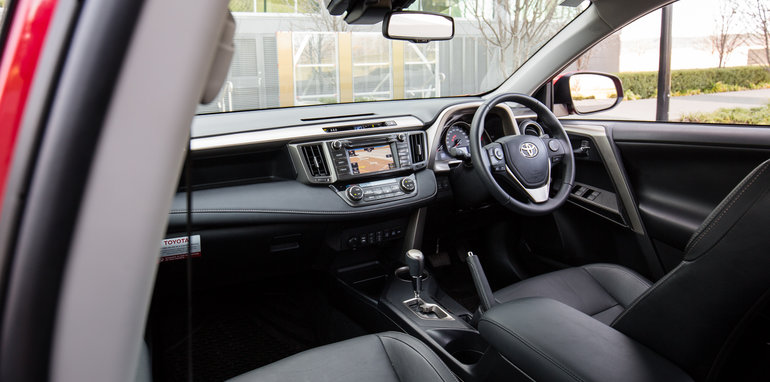
As the newest design, the Tucson also feels the mostly cleverly packaged for interior room. Between the front footwells and the cargo area, it seems to have the most length and legroom in both rows, and its generous cabin width makes it the friendliest for hauling five adults in reasonable comfort. That said, there’s not much in it, accommodation-wise, between the Hyundai and the evergreen RAV4.
Space isn’t everything â€" or, at least, the ultimate selling point â€" and the CX-5 proves it. The Mazda has smallest holistic cabin space of the four, and indeed the tightest boot space, but what it lacks in real estate it most certainly makes up for in panache and a premium lift that leaves its rivals feeling a little low-rent. Nice materials, a simple, clean and modern design and the superior upmarket appeal of the MZD Connect infotainment puts buyer bums in Mazda seats, and the most shapely, supportive and body-hugging seats of this pack by a fair margin.
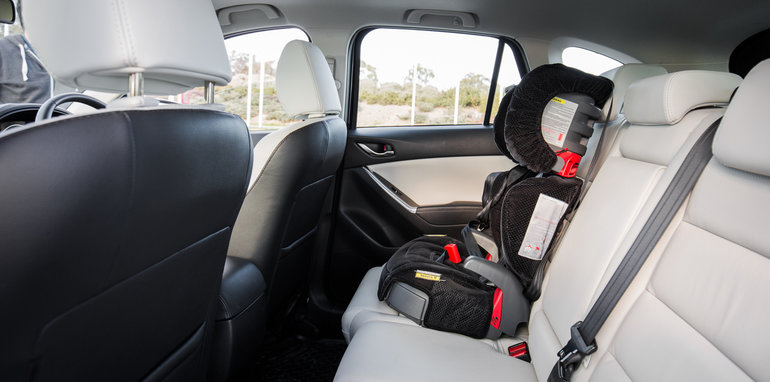
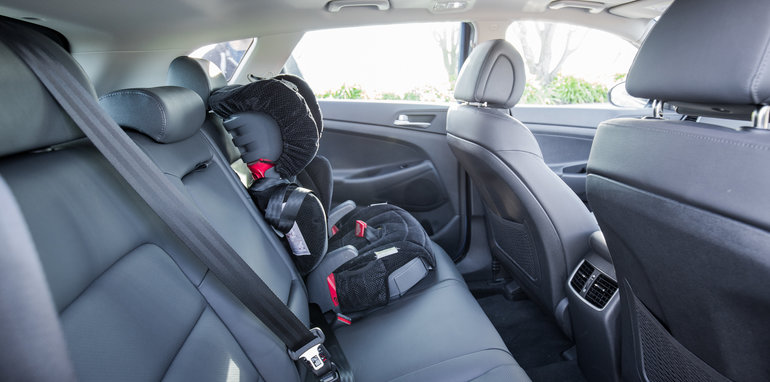
Pictured above: Mazda CX-5 (top); Hyundai Tucson (below)
The RAV4 couldn’t be more different, at once fussy in its curvaceous dashboard design, garish fake carbonfibre trim bits and oh-so-Lexus titanium-look accents, yet clearly is becoming long in the tooth despite all its garnish. The infotainment system, in particular, is tiny compared with rival systems and is dated in presentation. And while the front row seats balance comfort and sportiness nicely, the second row seating is plain and the suppleness â€" or lack thereof â€" of the leather trim doesn’t really live up to the Cruiser’s bullish price tag.
The Forester’s seating isn’t as supportive as its rivals, the cabin’s plastics look cheap in areas and it’s lacking in flash and fruit in present company. But the dual-screen arrangement provides a lift, the simple-to-use pinch-and-scroll infotainment system is one the better units in test, and the frosted silver and piano black highlights are suitably classy. It’s not brimming with features but it makes do with what it has commendably. However, the lack of parking sensors, second-row ventilation and digital speedometer can’t be compensated for with its what’s-the-point wheel-mounted paddleshifters in a car clearly without sporting pretensions.
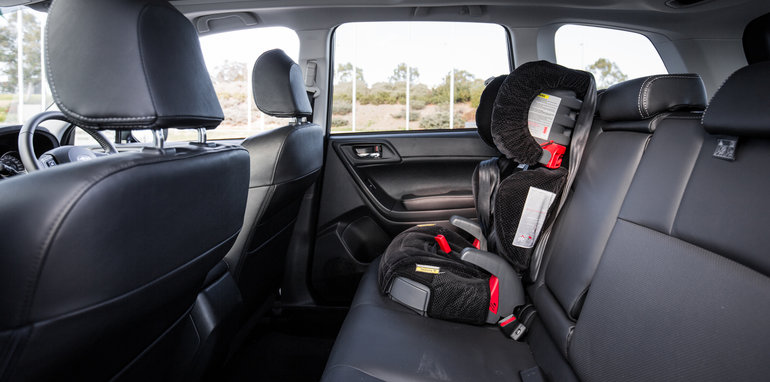
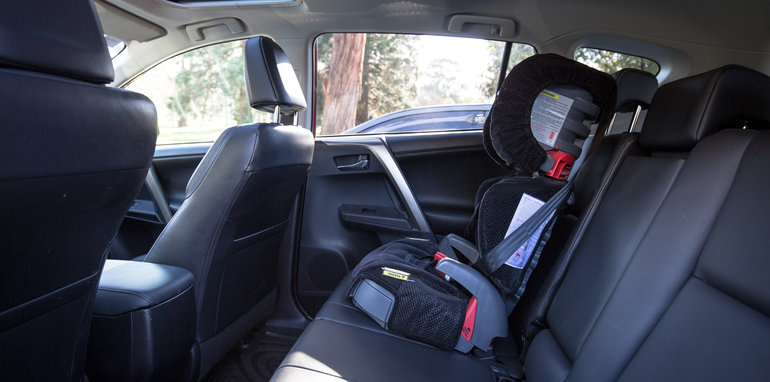
Pictured above: Subaru Forester (top); Toyota RAV4 (below)
Given its leading-edge exterior styling, the Tucson’s cabin is a mild letdown. It’s neat and nicely resolved, but there’s nothing about it that delivers the ‘next generation’ vibe you’d reasonably expect from an all-new design. And, given the Highlander’s top billing, there’s an auspicious absence of the Apple CarPlay connectivity that’s available in lower-level variants.
There are pluses. The Tucson is the only SUV of this bunch to offer rear air vents, and the only competitor here with a digital speedo. And while the front seats are more relaxed in contour than the CX-5’s, they too feature perforated leather, though unlike the Mazda the pews are both heated and cooled, while map lights are super-bright LEDs.
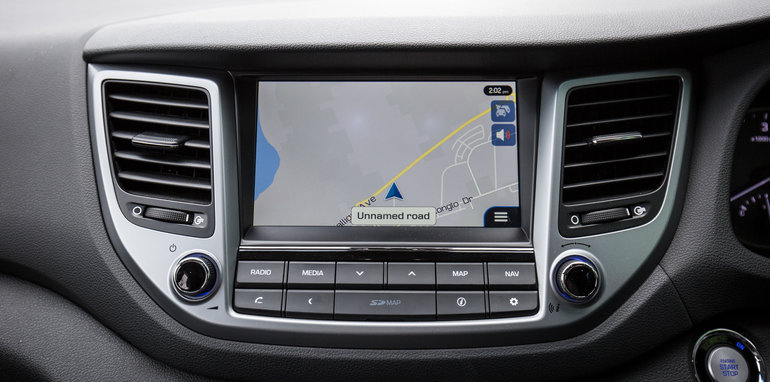
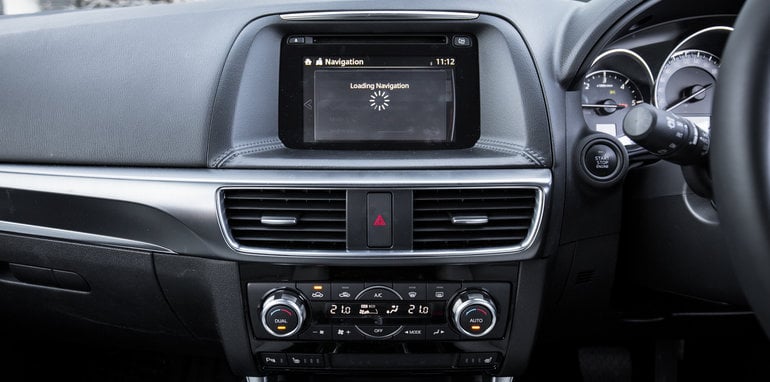
Pictured above: Hyundai Tucson (above);Â Mazda CX-5 (below)
So we’ll call it a win for the Tucson here, not merely on sheer space but for offering the most complete all-round package of necessities and conveniences.
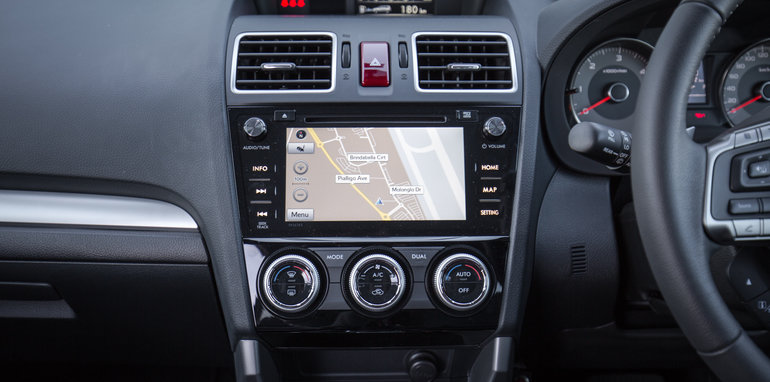
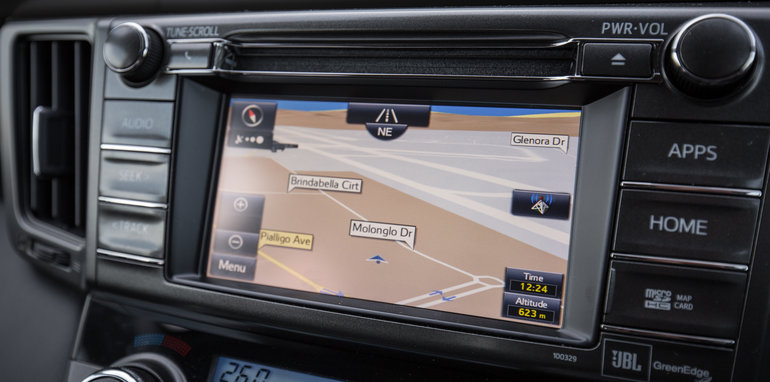
Pictured above: Subaru Forester (above); Toyota RAV4 (below)
Cargo area
Off the bat, the RAV4 creams the competition with a whopping 577 litres of cargo space, rear 60:40 split seats up. The caveat, however, is that a cost-optional spare wheel not only wants for $300 but eats into the cargo space, robbing 71 litres (506L total).
The Tucson comes with a spare wheel as standard and the floor is quite a bit higher than that of the Toyota’s, making it a less-favourable load height but also less back-breaking for parents who prefer the convenience of nappy-changing in the load area. And at 488 litres with its second row in play, there’s ostensibly a mere 18 litres separating the pair. Both have electric tailgate functionality, though the Hyundai has a larger opening making it easier to load bulky cargo.
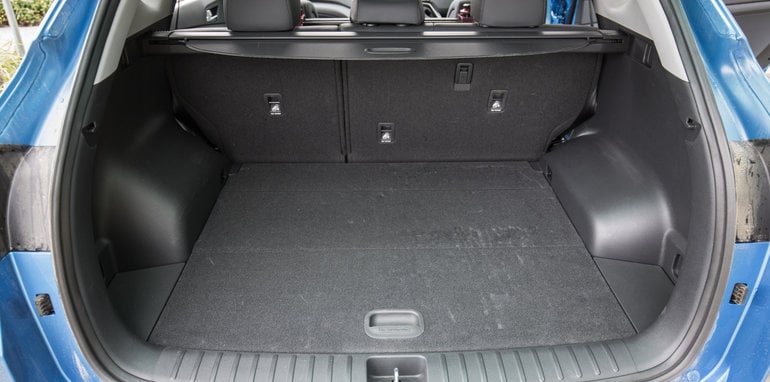
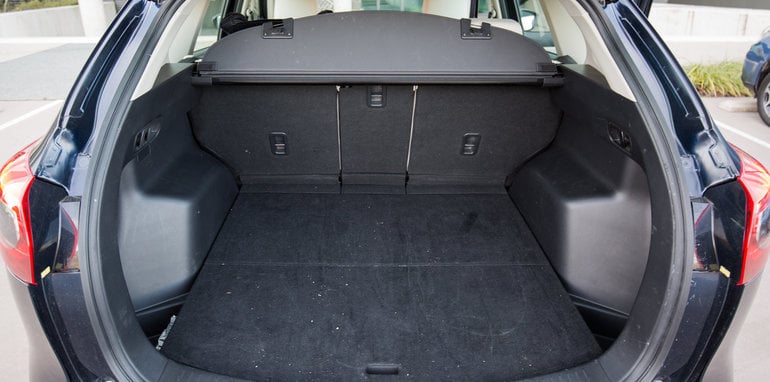
Pictured above: Hyundai Tucson (above); Mazda CX-5 (below)
From here it’s a fair drop to the Forester’s 422-litre (full-size spare included) and the CX-5’s modest 403-litre luggage areas. The Mazda offers a flexible 40:20:40 rear seatback configuration though, in its company of electric-assisted rivals, is the sole vehicle here with manual-only tailgate actuation. Â
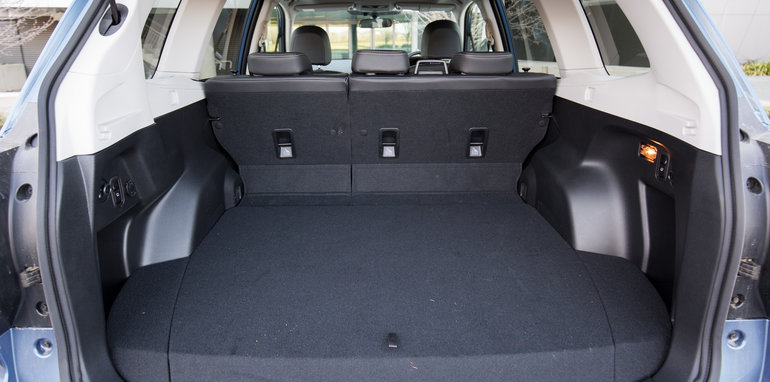
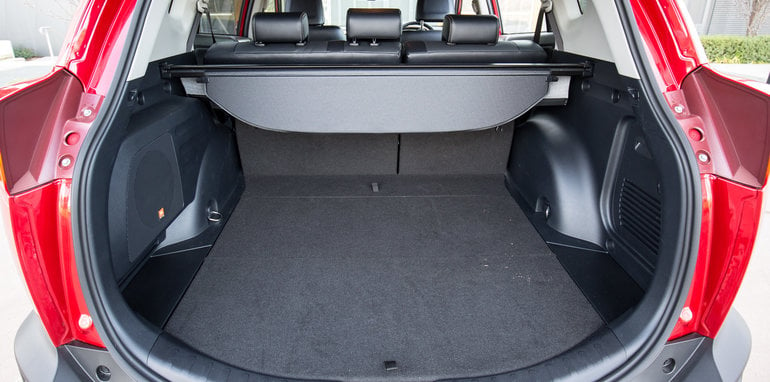
Pictured above: Subaru Forester (above); Toyota RAV4 (below)
For load-lugging, it’s the RAV4 over the Tucson by a slim margin.
Engine and transmission
Of this all-diesel, all-four-cylinder group, there’s quite a spread in power between the most-powerful protagonist, the 136kW Tucson, and the least-powerful upstart, the 108kW Forester. Both are 2.0-litre units. The RAV4 and CX-5, though, have larger 2.2-litre engines, the former edging ahead of the Subaru with 110kW, the latter a more burly 129kW. Clearly the Hyundai is working harder for its keep than the Toyota, though this is less consequential to hauling families in the daily grind than factors of torque, torque spread, and how effectively their respective automatic transmissions are at keeping their paired engines on the march when duty calls.
The CX-5 rules the torque roost with a formidable 420Nm, followed by the Tucson (400Nm), the Forester (350Nm) and the suddenly lazy-looking RAV4 (340Nm).
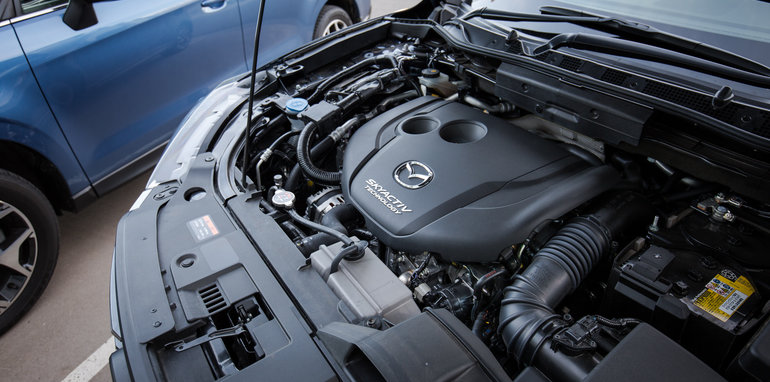
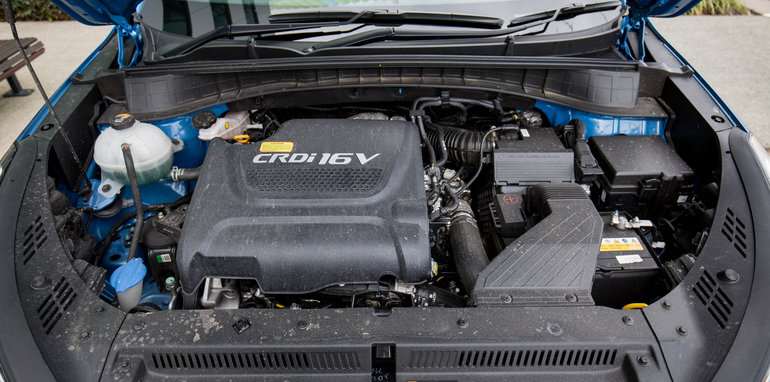
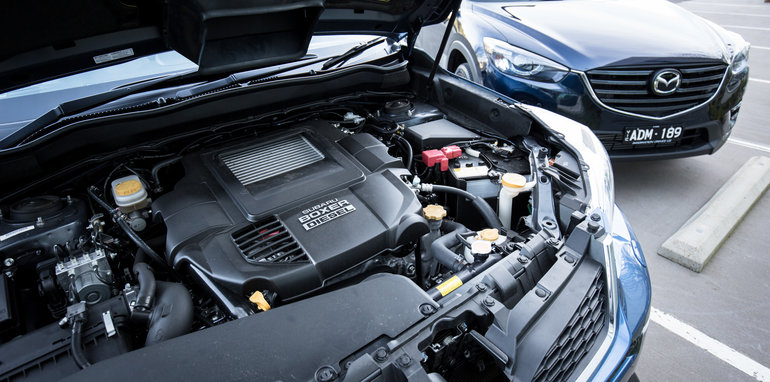
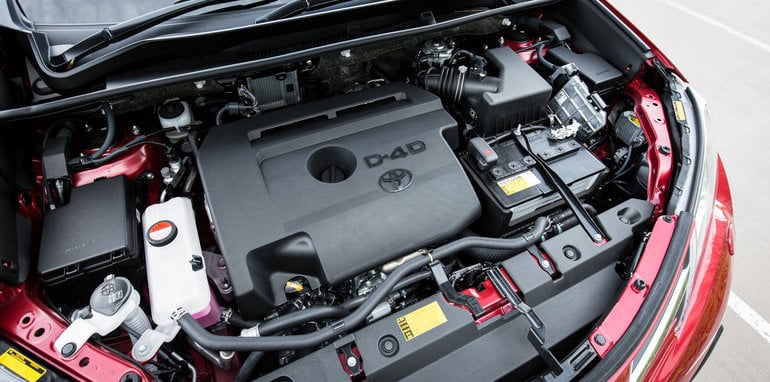
The RAV4 does ply its 340Nm across a broad 1700-3500rpm rpm range, though it doesn’t sound terribly happy doing so: it’s rattily at idle and noisy under load, and with its full 110kW clocking at just 3600rpm it runs out of puff easily. That six-speed auto is workmanlike, and activating Sport mode does sharpen responses marginally, though it merely makes the RAV4 peakier under foot and doesn’t bring much to the party.
The Forester’s 350Nm is available in a much narrower 1600-2400rpm band, though Subaru’s current generation of continuously variable transmissions does an admirable job of not simply keeping the engine on the boil, but faking ‘gearchanges’ for a convincing impersonation of conventional automatic character. In short, the Subaru always seems to punch, and punch well, in any driving situation, from stop-start traffic, where it’s little noisy, to open road cruising, where it’s whisper quiet. Those paddleshifters, though, seem ambitiously out of kilter in a non-sporting medium-SUV format. Â
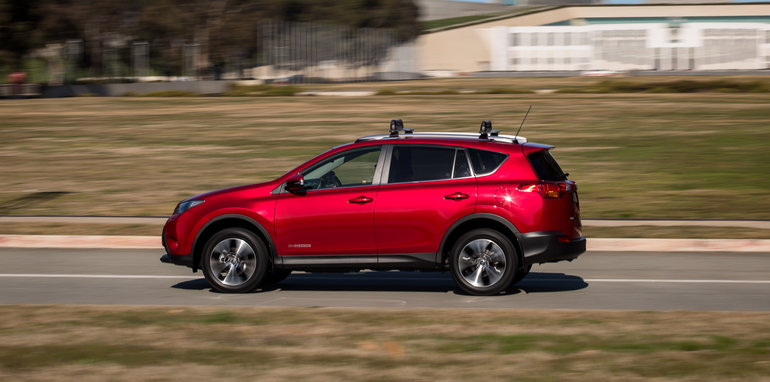
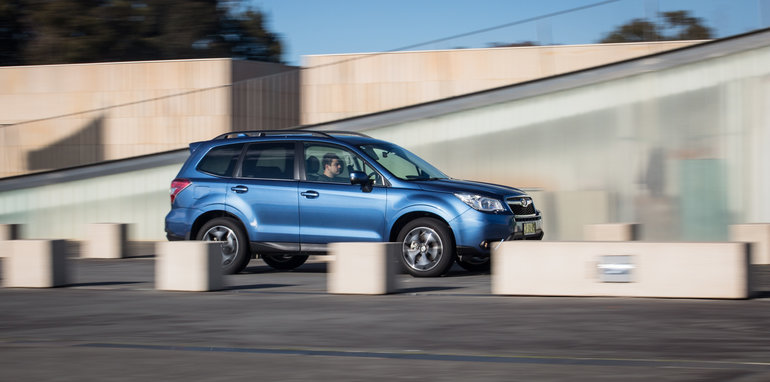
Both the CX-5 and Tucson are more effortless and properly swift on the march. It’s very tough to split the two, though the Hyundai is a little keener when loaded to the hilt with luggage and occupants. That said, for usage energy and all-round drivability, either offering wants for little.
However, it’s the Tucson that is noticeably the quietest, most refined through its rev range and perhaps most sweetly matched to its six-speed transmission, all of which conspires to give a real premium sheen.
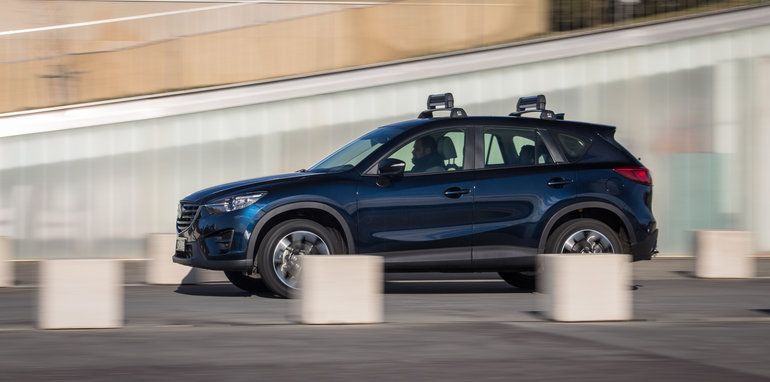
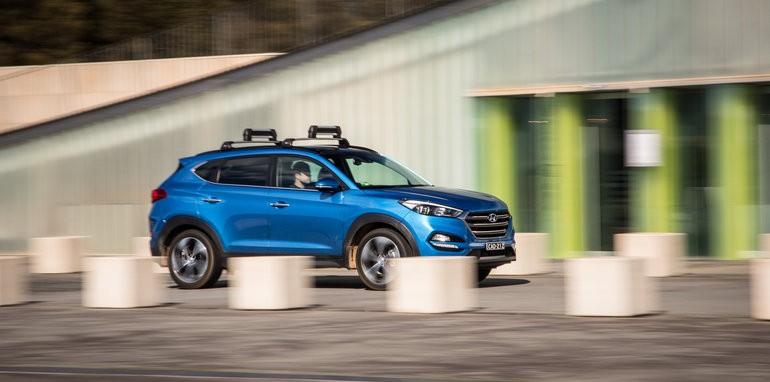
The extra gutsiness of the Mazda and Hyundai comes at a negligible penalty at the fuel pump. On-test consumption against their respective makers’ combined claims are as follows: the CX-5 returned 8.5L/100kms (5.7L claimed), the RAV4 8.2L (6.5L), the Tucson 8.0L (6.8L) and the Forester, the most frugal on show and closest to its claim, with 7.4L (6.4L). Â
Right here, it’s starting to look like this four-way test is the Tucson’s to lose…
Ride and handling
That refinement in the Tucson’s powertrain continues through the rest of the driving experience. Let’s not beat the bushy stuff: Hyundai made quite a noise about its new boy’s extensive chassis development at the recent launch, the results of which make for easily the quietest and most comfortable SUV of this four.
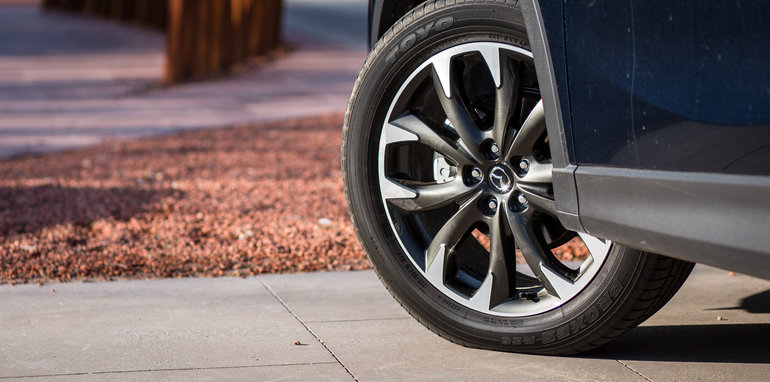
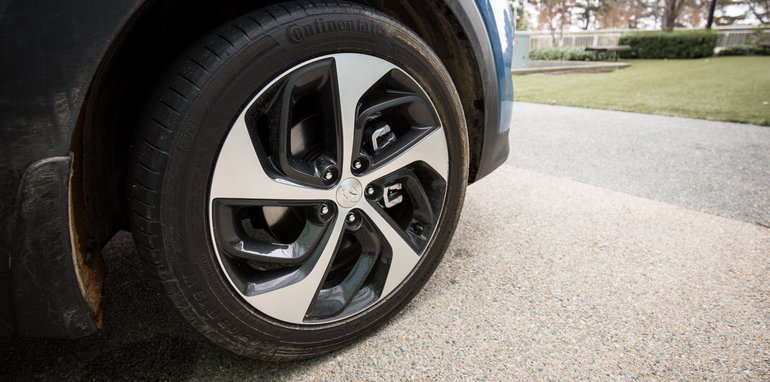
The Tucson’s ride quality, even on 19-inch wheels and fairly low-profile rubber, is excellent. It’s not quite as tied to the road surface as the CX-5 and it can get slightly floaty over undulations, but it’s a worthwhile trade-off for the all-round comfort on show.
It does, though, feel like a large device: it’s a little less wieldy around town, it’s slightly harder to judge its extremities during low-speed manoeuvring and parking in tight spaces, despite the full gamut of camera-plus-sensors.Â

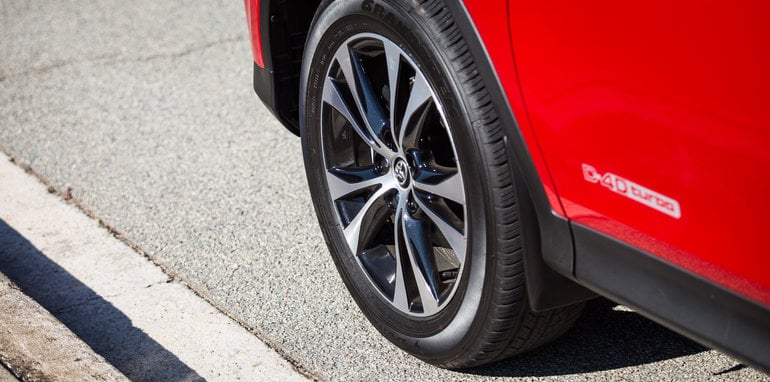
The CX-5 is quite the opposite. From behind the wheel, it feels compact, easy to place on the road, a doddle to park anywhere. It also sits on 19-inch wheels and is noticeably firmer than the Tucson, though quite compliant and downright pleasant over bumps and surface changes, if a little fidgety at low speed on crook roads.
While the Mazda lacks the Hyundai’s more cloud-like ride, the pay-off is its famously car-like driving character of clear (though slightly heavy) steering feel and a nice, crisp edge to the chassis. It’s easily the SUV of the four assembled that connects the driver the road most confidently. Â
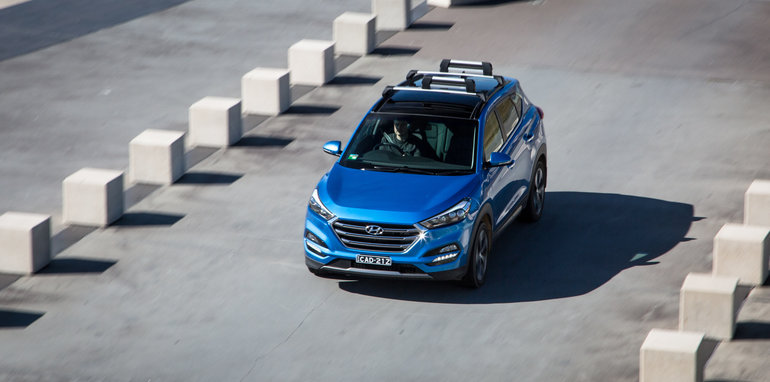
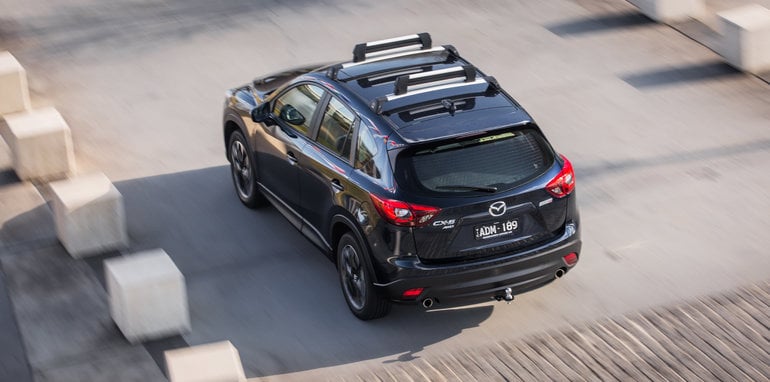
Ours was a purely on-road test, but it would be remiss not acknowledge the off-road capability of the Forester, the only permanent all-wheel drive in the company of part-time AWDs that are mostly-often front-drivers, and the drawcard this (plus X-mode electronic functionality) presents regional buyers. The Subaru’s inherent virtues of chassis balance and, comparatively, a sense of lightness on its feet makes for nice, easy-to-drive on-road experience, be it around town or out on the open road.
Despite the superb visibility, the lack of parking sensors makes it a chore to park. And if there’s a trade-off for its inherent multi-surface abilities, it’s that the Forester doesn’t steer as clearly nor feels as surefooted on the road as the CX-5, and it doesn’t offer the holistic comfort the Tucson does. Sat on 18-inch wheels, ride quality can also be downright unpleasant on unkempt surfaces.
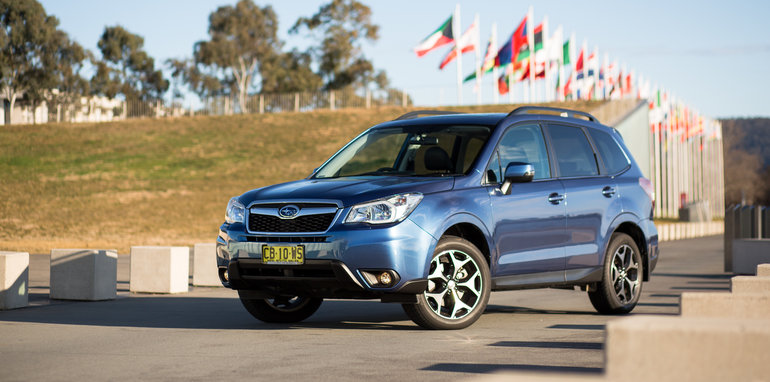
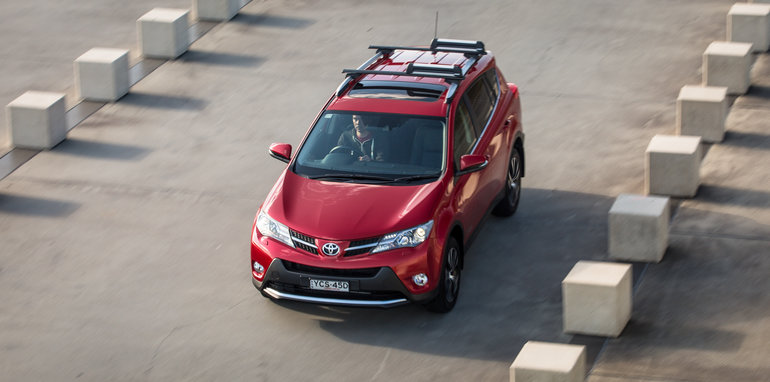
In this company, the RAV4 really struggles to shine. Particularly during mundane, around town driving duties that medium SUVs are normally tasked with. The ride comfort is most brittle and undisciplined of this group, alarmingly so on poor roads. Its steering is vague off centre, and there’s not much sense of connection with the road, despite the fact that square-edged surface imperfections â€" even cats-eye reflectors â€" are met with shocking thud through the chassis via its 18-inch wheels.
For on-road goodness, it’s the Tucson and CX-5 neck-and-neck, each shining brightly during the driving experience, though with quite different virtues and benefits.
Ownership
Hyundai’s iCare program covers Tucson with an impressive five-year/unlimited-kilometre warranty complete with a one-year free roadside assist and a complimentary sat-nav update and free first service (at 1500km). Service intervals are a long 12 months or lengthy 15,000km, whichever comes first.
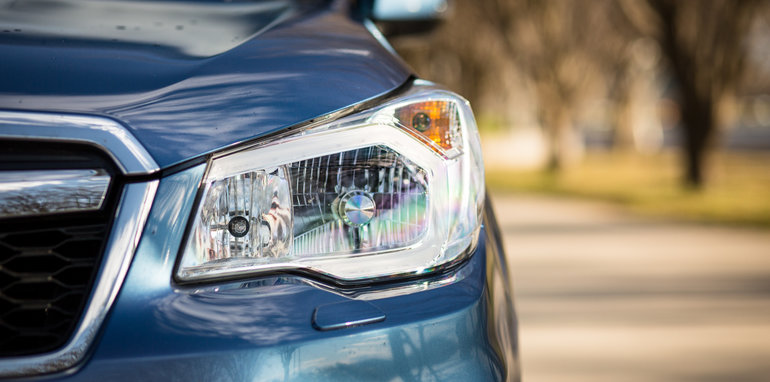
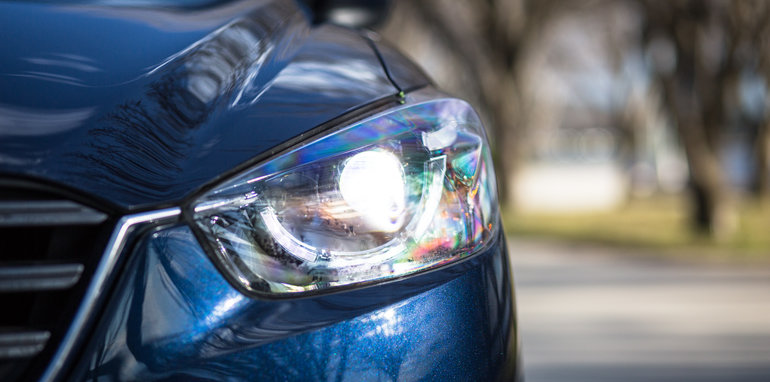
Both the CX-5 and Forester get three-year/unlimited kilometre warranties. The Mazda has longer service intervals of 12 months, though limited to an odometer count of 10,000km between servicing. The Subaru requires more frequency off the road, every six months, though has longer 12,500km intervals, capped for three years and a total of 75,000km.
Toyota’s warranty is also three years though capped at 100,000kms, with a three-year capped-price servicing schedule with intervals of every six months or 10,000km.  Â
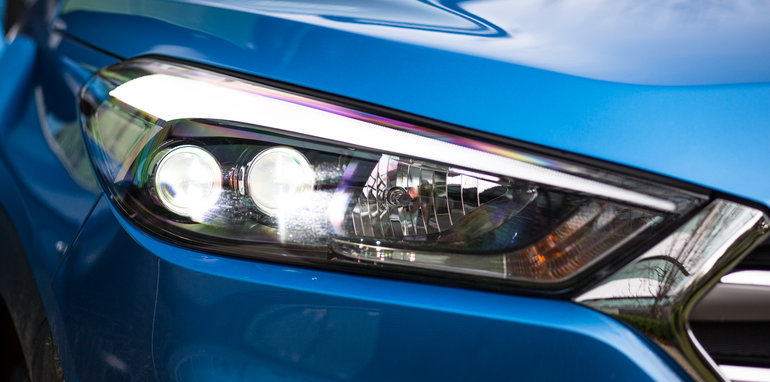
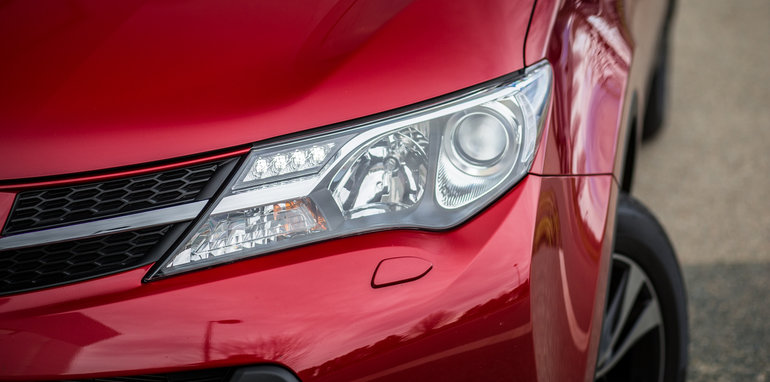
Verdict
The RAV4 has a history of failing to register highly in CarAdvice rankings. It remains pricey and continues to struggle put a best foot forward in any department, being below par in many areas. Despite its popularity â€" anchored no doubt on Toyota’s robust brand reputation â€" the value quotient is becoming increasingly questionable as newcomers such as the Tucson move the medium SUV game ever forward.
Similarly, the Forester trades strongly on reputation and track record, though both have been hard-earned by what’s ostensibly the segment originator in Australia. The recent addition of the diesel-automatic combination has improved the breed and, unlike Toyota, Subaru has been cutting prices and sharpening value to maintain relevancy in what’s in ageing product. It’s a great product, if one that’s beginning to struggle to keep up with the times. It is, though, perhaps the pick of the bunch for those keen on, ahem, a dirty weekend adventure. Had this been an off-road test…
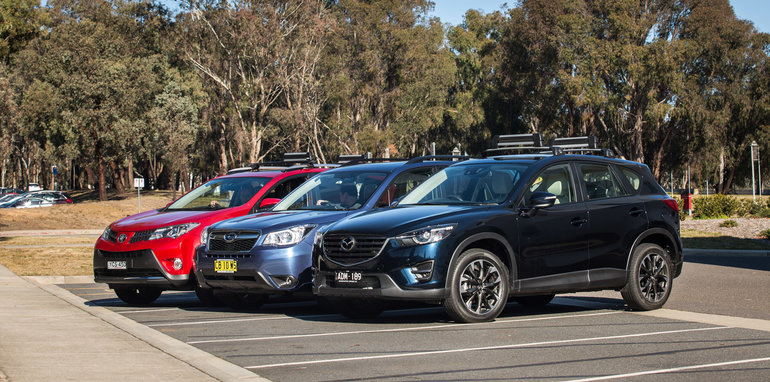
Driving enjoyment, feel-good factor, class-leading interior quality and connectivity, genuine sportiness, around town friendliness; the CX-5 has not only proven to offer the oh-so-sweet blend to lure urbanite buyers but has the right stuff that’s proven close to unbeatable in CarAdvice’s medium SUV tests past. And it asks a pretty penny for it (that clearly many buyers are willing to part with).
However, the Tucson lobs burgeoning with features and a sharper price point. It’s more spacious in accommodation, has a larger cargo capacity, is quieter, more refined and more comfortable for both short- and long-haul trips.
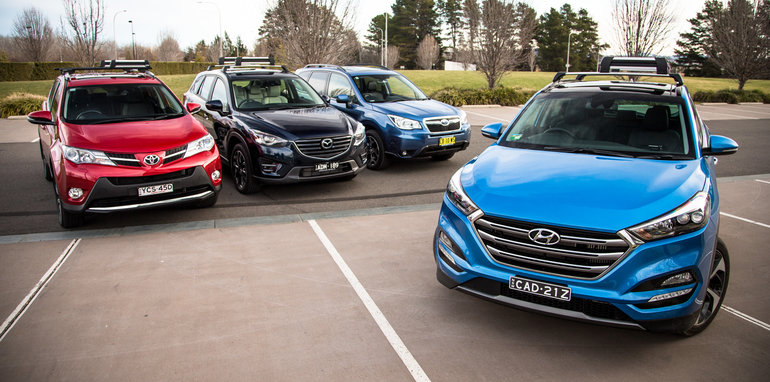
Either the CX-5 or Tucson would be the ideal choice depending on the individual buyer’s wants and needs. But on balance of this particular test, the Hyundai surpasses the CX-5 by ticking more essential medium-SUV boxes more confidently, while offering fewer compromises in the business of hauling families.
Click the Photos tab to see all images by Tom Fraser.
Videography by Mitchell Oke.
Comments
Post a Comment